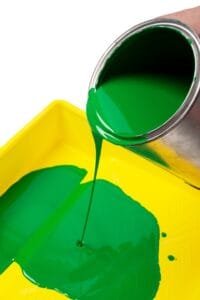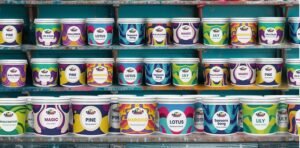Introduction to chemical components of paint
Paint, a vital element in both residential and commercial spaces, is an intricate blend of various chemical components that serve specific purposes. At its core, paint is composed of pigments, resins, solvents, and additives, each playing a crucial role in the overall function and effectiveness of the product. Understanding the chemistry of paint, including the interaction between these constituents, is essential for manufacturers and consumers alike. This understanding not only influences the quality and durability of paint but also informs decisions related to application and performance.
When we consider the manufacturing of products like Mithila home paints, it becomes apparent that the choice of chemical ingredients directly affects the aesthetic qualities, protective features, and environmental impact of the paint. For instance, the pigments provide color and opacity, while the resins bind the pigments to the surface, ensuring a cohesive application. Solvents are used to dissolve these components, allowing for a smooth application, while additives enhance specific properties such as drying time, mildew resistance, and texture.
Furthermore, the importance of understanding paint chemistry extends beyond functional attributes; it has significant implications for health and environmental safety. Many traditional paint formulations contain volatile organic compounds (VOCs), which can be harmful to both human health and the environment. The ongoing shift towards water-based and low-VOC options, such as those found in Mithila home paints, highlights the industry’s commitment to sustainability. As consumers become increasingly aware of these factors, their choices can influence market trends, driving manufacturers to innovate and adapt. Ultimately, a fundamental grasp of paint chemistry empowers informed decisions that promote not only functionality and aesthetics but also environmental stewardship.

The Role of Pigments
Pigments play a crucial role in paint formulations, significantly influencing the color, opacity, and overall performance of the finished product. These finely ground particles allow for the vibrant hues and shades that are a hallmark of quality paints, such as mithila home paints. Pigments can be broadly categorized into two main types: organic and inorganic.
Organic pigments are carbon-based compounds, often providing bright colors and high tinting strength. They are commonly used in applications where a vivid and varied color palette is desired. However, organic pigments may be less durable under certain environmental conditions, which can lead to fading over time. In contrast, inorganic pigments include metal oxides and salts, renowned for their stability and opacity. These pigments tend to exhibit excellent lightfastness and resistance to weathering, making them ideal for outdoor applications where longevity is paramount.
The choice between organic and inorganic pigments ultimately depends on the specific requirements of the paint. For instance, mithila home paints utilize a blend of both types to achieve a balance of color vibrancy and durability. This careful selection is paramount not only for aesthetics but also for the paint’s overall lifespan and performance.
In addition to their color properties, pigments also play a keystone role in the opacity of paint, determining how well the underlying surface is concealed. This trait is particularly critical for home improvement projects. The application of high-opacity pigments can reduce the number of coats required, streamlining the painting process and enhancing the final appearance.
Understanding the various types of pigments and their respective attributes enables consumers to choose the right type of paint for their needs. This knowledge empowers homeowners to select products that not only beautify their living spaces but also ensure lasting quality, exemplifying what mithila home paints stands for.
Binders and Resins: The Heart of Paint
Binds and resins are fundamental components of paint, providing the essential link between the pigments and the surface they are applied to. Their primary function is to adhere the pigment to the substrate while ensuring the longevity and durability of the finish. The selection of binders significantly influences the performance characteristics of the paint, including the ease of application, durability, and the overall appearance of the final coat.
There are several types of binders used in the formulation of paints, each possessing unique properties. Acrylics are one of the most common binders, known for their water-solubility and versatility. They dry quickly, making them ideal for both interior and exterior applications. Acrylic-based paints are often favored for their flexibility and resistance to UV radiation, which helps to prolong the integrity of the color when exposed to sunlight.
Alkyd resins, derived from natural oils, are another popular choice, particularly in environments where an oil-based finish is preferred. Alkyd paints provide a hard, durable finish that is resistant to wear and tear, making them suitable for high-traffic areas and outdoor applications. The drying process for alkyds is slower than that of acrylics, allowing for a smoother application and a glossy finish upon drying.
Epoxy resins act as a robust binder, renowned for their chemical resistance and adherence to a variety of surfaces. Epoxy paints are often used in industrial settings where durability is paramount, as they can withstand harsh conditions and spills without compromising their integrity or finish. These resins offer a strong protective layer, making them ideal for environments like garages, warehouses, and laboratories.
In conclusion, the selection of binders plays a crucial role in determining the characteristics and performance of mithila home paints. Understanding these components will help consumers choose the right paint for their specific needs, ensuring the best possible outcome for their projects.
Solvents and Thinners: Who Needs Them?
When discussing the formulation of paints, it is essential to consider the role of solvents and thinners, integral components that significantly influence the final product. Solvents are typically liquids used to dissolve or disperse other substances within paint, thus facilitating the application process. On the other hand, thinners are additives designed to alter the viscosity of the paint, ensuring that it can be easily applied to surfaces. For instance, mithila home paints often utilize specific thinners to achieve a smooth finish, ensuring optimal performance.
The volatility of solvents plays a crucial role in determining how quickly a paint dries. Volatile solvents evaporate quickly, which can speed up the drying time of paint, making them necessary for applications where time is of the essence. However, this rapid evaporation can also lead to issues such as blistering or uneven finishes if not managed appropriately. Various types of solvents, ranging from mineral spirits to more environmentally friendly options, are available to cater to different user needs and painting conditions. Selecting the right solvent for mithila home paints is vital for achieving the desired results and ensuring consistent application.
Additionally, the importance of attaining the correct viscosity cannot be understated. Viscosity affects how easily paint can be spread and its ability to adhere to a surface. Too thick a mixture may lead to application difficulties and poor finish quality, while a too-thin consistency could result in drips and runs. Thus, the use of the right thinners and solvents ensures that mithila home paints can be applied effectively, leading to an aesthetically pleasing and durable outcome. Recognizing the balance between these components is essential for any painting project, directly influencing both performance and finish.

Additives: Enhancing Performance
Additives play a vital role in the formulation of paints, significantly contributing to their overall performance and durability. These chemical constituents can enhance various characteristics of paints, from their application properties to longevity. Understanding the different types of additives and their functions offers valuable insights for consumers and manufacturers alike, especially for those considering options like Mithila home paints.
One of the primary categories of additives in paint formulations is surfactants. These compounds are essential for improving the wetting properties of the paint, allowing it to spread evenly over a surface. By reducing the surface tension, surfactants ensure better adhesion and coverage. Their role is particularly crucial in water-based paints, commonly used in residential applications including Mithila home paints, as they help achieve a smoother finish.
Stabilizers are another key group of additives, designed to maintain the uniform dispersion of pigments and other solids within the paint. These additives prevent settling and separation during storage, ensuring that the paint remains homogenous throughout its shelf life. This stability is critical for consumers who want to ensure a consistent color and texture upon application, which can be especially important in decorative spaces painted with Mithila home paints.
Additionally, anti-foaming agents serve a specific purpose in improving the application process. They mitigate the formation of foam during mixing and application, which can lead to surface imperfections. By incorporating these agents, paint manufacturers can ensure a smoother application, reducing the potential for defects that could compromise the final appearance.
Lastly, biocides are incorporated to enhance the longevity of paint by preventing microbial growth on the surface. This is particularly essential for interior environments, where maintaining a healthy living space is crucial. Together, these additives ensure that paints like Mithila home paints not only perform well upon application but also retain their quality and aesthetic appeal over time.

Environmental Considerations: VOCs and Eco-Friendly Alternatives
The understanding of the chemical components of paint includes an evaluation of environmental considerations, particularly focusing on volatile organic compounds (VOCs). VOCs are a group of organic chemicals that significantly contribute to indoor air pollution. When traditional paints are used, VOCs are released into the air, leading to a decline in indoor air quality. Prolonged exposure to paints containing high levels of VOCs can result in various health issues, ranging from respiratory problems to headaches and dizziness. This is a pressing concern for households utilizing conventional paint products, illustrating the importance of selecting alternatives that mitigate these risks.
In recent years, there has been a growing necessity for eco-friendly alternatives to conventional paints. One such option is water-based paints, which typically contain fewer VOCs, making them a healthier choice for both the environment and the individuals residing in these painted spaces. Water-based formulations utilize water as a solvent rather than harmful chemicals, which significantly reduces pollutants being released into the air. As a result, mithila home paints often focus on providing such options, appealing to environmentally conscious consumers who wish to maintain a healthier living space.
Additionally, natural pigments represent another noteworthy eco-friendly alternative that can be utilized in paint formulations. Derived from minerals and plants, these pigments contribute to the creation of vibrant colors without the harmful effects commonly associated with synthetic dyes. Homeowners can thus explore mithila home paints that incorporate these natural components, supporting a more sustainable approach to interior design. As awareness of the impact of traditional paints continues to grow, the shift towards low-VOC and natural formulations remains imperative for fostering a healthier environment.

Safety Considerations When Handling Paint
When engaging in any painting project, understanding the safety considerations associated with handling paints, including mithila home paints, is paramount. Paints often contain a variety of chemical components that can pose health risks if proper precautions are not taken. Inhalation of fumes, skin contact, or accidental ingestion can lead to adverse health effects. Organics solvents and heavy metals are commonly found in many paint formulations, and exposure to these substances can cause respiratory issues, skin irritations, or other serious health problems.
To mitigate these risks, personal protective equipment (PPE) should be employed. This includes wearing gloves to prevent skin contact, safety goggles to protect the eyes from splashes, and masks or respirators to filter out harmful vapors from the air. When working with paints, especially those with a high volatile organic compound (VOC) content, it is critical to ensure adequate ventilation in the workspace. Opening windows and using exhaust fans can help reduce the concentration of hazardous fumes. For larger projects or prolonged exposure, consider using professional-grade respirators designed to filter out specific paint components.
Storage of paint products, such as mithila home paints, also warrants attention. Paints should be stored in their original containers, tightly sealed to prevent spills or leaks. It is advisable to keep paints out of reach of children and pets, and in a cool, dry place away from direct sunlight or heat sources, which could trigger chemical reactions. Furthermore, proper disposal of paint is essential to eliminate any environmental hazards. Many local waste management agencies provide guidelines and facilities for the disposal of paints, which should always be followed to ensure safety and compliance with regulations.
Understanding Paint Labels and Specifications
Reading and interpreting paint labels and product specifications is essential for consumers looking to make informed choices, particularly when selecting options like mithila home paints. Paint labels often contain various information regarding the chemical composition, performance attributes, and applicable certifications. Understanding these elements will empower buyers to choose products that best meet their needs.
To begin with, the chemical composition is typically indicated on the label, listing key ingredients such as pigments, solvents, and binders. Pigments determine the color and opacity of the paint, while solvents facilitate application and drying. Binders are crucial as they ensure the paint adheres to surfaces and provides durability. By familiarizing oneself with these components, consumers can assess the potential environmental impact, health risks, and suitability of a paint for specific applications.
Moreover, labels often include performance attributes that detail how well a paint will function under different conditions. For instance, consumers may find specifications regarding drying time, coverage per gallon, sheen levels, and washability. Understanding these performance metrics is vital for achieving desirable results, particularly in residential settings, where mithila home paints may be applied to walls, trims, or ceilings.
Additionally, consumers should pay attention to certifications that guarantee the product meets specific safety and environmental standards. Certifications like Greenguard or SCAQMD reflect compliance with stringent regulations, thereby providing reassurance regarding the product’s indoor air quality and low-emission properties. These assurances can sway buyers towards premium options like mithila home paints, known for their quality and eco-friendliness.
In summary, effectively reading and interpreting paint labels is integral for making educated purchasing decisions. By understanding the components, performance attributes, and certifications, consumers gain the necessary knowledge to select products that align with their particular specifications and needs.

Conclusion: The Future of Paint Chemistry
As we draw our discussion on the chemical components of paint to a close, it is clear that understanding these elements is crucial not only for professionals in the industry but also for consumers seeking informed choices. The paint industry is on the cusp of significant transformation driven by advancements in technology and an increasing emphasis on sustainability. Innovations such as advanced polymers and bio-based solvents are paving the way for more environmentally friendly products, including options like mithila home paints, which are not only effective but also pose a reduced risk to health and the environment.
The emergence of nanotechnology is another exciting trend influencing paint chemistry. The incorporation of nano-sized particles can enhance the performance of paints significantly, improving properties such as durability, scratch resistance, and even energy efficiency. For example, the reflective quality of certain paints can be augmented through these innovative techniques, leading to energy savings and a smaller carbon footprint. Brands producing mithila home paints are paying close attention to these developments, ensuring their offerings align with modern demands for both quality and sustainability.
Moreover, the regulatory landscape is evolving, encouraging manufacturers to adopt greener practices. The possibility of stricter regulations regarding VOCs (volatile organic compounds) pushes the industry towards more compliant formulations that enhance indoor air quality. As consumers become increasingly aware of the health implications associated with traditional paints, the demand for low-VOC and non-toxic alternatives, including those within the mithila home paints range, is likely to grow. This will ultimately shape the future of paint chemistry as companies innovate to meet these expectations.
In summary, the future of paint chemistry appears bright, with a clear trajectory towards greater sustainability, advanced technologies, and healthier products. Stakeholders in the paint industry must remain nimble, ready to adapt and innovate in response to these changing trends, facilitating an ongoing evolution that benefits both consumers and the planet.


